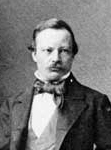Edvard Raphael Scheutz
Born September 13, 1821, Stockholm, Sweden; died January 28, 1881, Stockholm, Sweden; son in the Swedish father-and-son team who in 1853 constructed the world's first commercially available, operational Difference Engine after the style of Charles Babbage.

Education: qualified as an engineer, Technological Institute, Stockholm, 1841.
Honors and Awards: Medaille d'Honneur, L'Exposition Universelle de Paris, 1855.
Around 1830 Edvard's father, Georg Scheutz, first learned of Babbage's work on the Difference Engine. Through the publication of Dionysius Lardne [Lardner, Dionysius, "Babbage's Calculating Engine," Edinburgh Review, No. 120, July 1834.] in 1834, he received more detailed information. Georg began to experiment with models of wood, pasteboard, and wire, and soon developed some improvements with the assistance and ingenuity of his son Edvard, then a teenager. By 1842 they had built a calculating unit which was capable of third-order differences; they completed their first engine in 1843, including the printing unit. With funding from the Swedish Academy of Sciences, a second Difference Engine was built according to the Scheutz' plans by Johan Bergström. It was completed in 1853, and was sold to the Dudley Observatory in New York in 1857. A copy of this engine was ordered by the General Register Office in London. Built by Bryan Donkin and Co., this machine was delivered in 1859 and was put to work to produce life-time tables. The Scheutzes and Babbage met for the first time in late 1854, by which time Babbage was deeply involved in his design of the Analytical Engine, his Difference Engine never having been completed. Babbage, however, undertook to publicize the Scheutz machines, designating his son Prevost to develop a notation for describing their second engine.
Edvard went on to complete two other inventions of his own: the rotary steam engine and a methodology for the printing of postage stamps.
The "difference engine business" did not bring the Scheutz family the expected financial returns. Edvard died in 1881 at the age of 59, bankrupt; the Difference Engine's notoriety died with him. [Reviewed and corrected by Michael Lindgren, National Museum of Science and Technology, Stockholm.]
BIBLIOGRAPHY
Biographical
Chase, George C., "History of Mechanical Computing Machinery," Ann. Hist. Comp., Vol 2, No. 3, 1980, pp. 198-226.
Lindgren, Michael, Glory and Failure: The Difference Engines of Johann Müller, Charles Babbage, and Georg and Edvard Scheutz, MIT Press, Cambridge, Mass., 1990.
UPDATES
Portrait added (MRW, 2013)
New content Copyright © 2013-2023 by the IEEE Computer Society and the Institute of Electrical and Electronics Engineers Inc.
All rights reserved. This material may not be reproduced or redistributed without the express written permission of the copyright holder.
